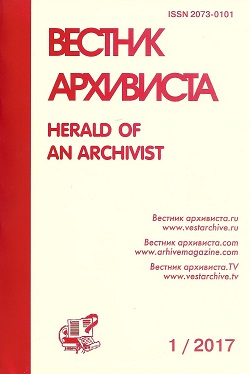Stone church construction in Vologda and in the Trinity-Sergiev Monastery in the last third of the XVI century



Scientific article
doi 10.28995/2073-0101-2024-2-495-507
For citation
Davidenko, Dmitrii G. (2024), “Stone church construction in Vologda and in the Trinity-Sergiev Monastery in the last third of the XVI century”, Herald of an Archivist, no. 2, pp. 495-507. doi 10.28995/2073-0101-2024-2-495-507
Davidenko, Dmitrii G., Institute of Archaeology, Russian Academy of Sciences, Moscow, Russia
Stone church construction in Vologda and in the Trinity-Sergiev Monastery in the last third of the XVI century
Abstract
The article deals with the origin and history of stone construction in Vologda in the 16th century, especially in the last third of the century, when the St. Sophia Cathedral, the fortress and, judging by some information, several stone structures inside the fortress were built. Simultaneity and compactness of the construction allows us to assume the participation of one large brigade. Researchers drew attention to the participation of foreigners Razmysl and H. Locke in the building of the Vologda fortress. But the volumes of construction directly indicate the multiplicity of its participants. In the act of the Trinity-St. Sergius Monastery of January 13, 1586 the Vologda mason Leonty (Pozdey) Vasilyev’s son is noted, who sold the yard to the largest Russian monastery according to this document. Finding the mason in Vologda allows us to assume with a high degree of probability his participation in the sovereign city construction of the last third of the XVI century. The fact that his neighbors sold another part of the courtyard to the Trinity-Sergius Monastery in 1584 leaves no doubt about his acquaintance with the authorities of the Trinity-Sergius Monastery already at that time. Taking into account that in 1585 in this monastery the construction of the largest monastery building at that time - the Dormition Cathedral - was being completed, one can have no doubt that around the time of the transaction with the Vologda mason, the most important Russian monastery needed such specialists. This gives grounds for assumption about the work of the Vologda mason Leonty (Pozdey) Vasilyev’s son not only on sites in Vologda, but also in the Trinity-St. Sergius Monastery. Our assumption can be supported by architectural proximity of the Sofia Cathedral in Vologda and the Assumption Cathedral in the Trinity-Sergius Monastery, oriented on the main Russian temple - the Assumption Cathedral of the Moscow Kremlin. We take into account the interest of Tsars Ivan the Terrible and his son Fyodor Ivanovich in both the Vologda cathedral and the cathedral of the Trinity-St. Sergius Monastery, their location in the same direction from Moscow, as well as the perception of both monumental buildings as typologically similar not only in our days, but already at the end of the XVII century, a century after their building. Attention is drawn to the fact that the yard of the Vologda mason Leonty (Pozdey) Vasilyev's son was white, i.e. free from sovereign taxes, which was usual for the yards of sovereign craftsmen, which is symptomatic, since stone architecture in Vologda and in the Trinity-St. Sergius Monastery in the second half of the 16th century, which took place under vigilant sovereign control, was obviously carried out primarily by sovereign specialists.
Keywords
Historical source, Vologda Sophia Cathedral, Assumption Cathedral of the Trinity-St. Sergius Monastery, stone architecture, census book, Moscow Archive of the Ministry of Justice (MAMJ).
Download the article: davidenko_doi
References
Andrianova, L. S. I dr. (ed.) (2007), Arkheologiya Vologdy: istoriya i sovremennost'. Sbornik statei [Archaeology of Vologda: history and modernity. Collection of articles], Drevnosti Severa, Vologda.
Baldin, V. I. (1968), Arkhitektura [Architecture], in Voronina, N. N. Kostochkina. V. V. (ed.), Troitse-Sergieva Lavra. Khudozhestvennye pamyatniki [Troitse-Sergieva Lavra. Artistic monuments], Iskusstvo, Moscow.
Banige, V. S. and Pertsev, N. V. (1970), Vologda, Iskusstvo, Moscow.
Batalov, A. L. (1996), Moskovskoe kamennoe zodchestva kontsa XVI veka. Problemy khudozhestvennogo myshleniya epokhi [Moscow stone architecture of the end of the XVI century. Problems of artistic thinking of the epoch], Meiker, Moscow, Russia.
Shunkov, V. I.(ed.) (1969), Voprosy voennoi istorii Rossii XVIII i pervaya polovina XIX vv. [Issues of Russian military history of the XVIII and the first half of the XIX centuries], Nauka, Moscow.
Zimin, A. A. (1969), “Participant of the capture of Kazan in 1552 Litvin Rozmysl Petrov“, Shunkov. V. I. (ed.), Voprosy voennoi istorii Rossii XVIII i pervaya polovina XIX vv. [Issues of Russian military history of the XVIII and the first half of the XIX centuries], Nauka, Moscow, pp. 273–278.
Vasilieva, M. V., Vinogradova, E. A., Kamkin A. V. et al. (2022), Istoriya pravoslavnykh khramov i monastyrei Vologdy [History of Orthodox churches and monasteries of Vologda], Drevnosti Severa, Vologda, Russia.
Kirichenko, L. A. (2006), Aktovyi material Troitse-Sergieva monastyrya 1584–1641 gg. kak istochnik po istorii zemlevladeniya i khozyaistva [Act material of the Troitse-Sergiev Monastery 1584-1641 as a source on the history of land tenure and economy], RGGU, Moscow, Russia.
Kukushkin, I. P. (2018),Vologodskaya krepost' [Vologda Fortress], Drevnosti Severa, Vologda, Russia.
Novikova, O. L. (ed.) (2019), Letopisi i khroniki. Novye issledovaniya 2017–2018 [Chronicles and chronicles. New researches 2017-2018], Al'yans-Arkheo,Moscow, Saint-Petersburg, Russia.
Antonov, A.V. (ed.) (2016), Opisanie gramot Kollegii ekonomii T. 1. A–I [Description of the literatures of the Collegium of Economy T. 1. A–I], Drevlekhranilishche, Moscow, Russia.
Papin, I. V. (2007), “Secrets of the main building of Vologda: archaeological research of the St. Sophia Cathedral”, Andrianova, L. S. i dr. (ed.), Arkheologiya Vologdy: istoriya i sovremennost'. Sbornik statei [Archaeology of Vologda: History and Modernity. Collection of articles], Drevnosti Severa, Vologda, Russia, pp. 69-75.
Pugach, I. V. (ed.) (2018), Pistsovye i perepisnye knigi Vologdy XVII–nachala XVIII vv. T. 3. [Census and census books of Vologda XVII-early XVIII centuries Vol.2], Drevnosti Severa, Vologda 2018. 392 s.
Sokolova, I. V., Kamkina, N. M. (2018), “Vologda Sofia Cathedral: to the question of the consecration of the temple”, Vestnik tserkovnoi istorii, no. 3–4 (51–52), pp.125–134.
Suvorov, N. (1863), Opisanie Vologodskogo kafedral'nogo Sofiiskogo sobora [Description of the Vologda Cathedral of St. Sophia], Tip. Bakhmeteva, Moscow.
Skrynnikov, R. G. (1992), Tsarstvo terrora [Reign of Terror], Nauka, St. Petersburg, Russia.
Speranskii, A. N. (1930), Ocherki po istorii prikaza kamennykh del Moskovskogo gosudarstva [Essays on the History of the Order of Stone Affairs of the Moscow State], RANION, Moscow.
Voronina, N. N., Kostochkina, V. V. (ed.) (1968), Troitse-Sergieva Lavra. Khudozhestvennye pamyatniki Iskusstvo [Trinity-St. Sergius Lavra. Artistic monuments], Moscow.
Trofimov, I. V. (1961), Pamyatniki arkhitektury Troitse-Sergievoi lavry [Monuments of architecture of the Trinity-Sergieva Lavra], Gosstroiizdat,Moscow.
Shumakov, S. A.(2002), Obzor «Gramot kollegii ekonomii». Vyp. 5 [Review of "Gramot of the Collegium of Economy". Vyp. 5], Drevlekhranilishche, Moscow, Russia.
About the authors
Dmitrii G. Davidenko, PhD in History, Institute of Archaeology, Russian Academy of Sciences, research associate, Russian State University for the Humanities, research associate, Moscow, Russia, 8-916-505-34-23, This e-mail address is being protected from spambots. You need JavaScript enabled to view it
Grant information
The article was prepared with the financial support of the Russian Science Foundation (Project No. 20-18-00218)
The article was received in the editorial office on 12.12.2023, recommended for publication on 20.03.2024.











